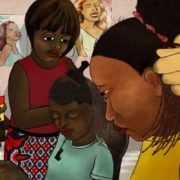Nigerian animator Ridwan Moshood was so determined to learn how to make cartoons, he spent hours in internet cafés in Lagos, watching YouTube lessons and taking notes.
— VIVIENNE NUNUS & SARAH TREANOR, BBC NEWS
“I would go to a cyber café, watch video tutorials and write down whatever I’d learnt,” he says.
Today, the 26-year-old is a rising star in Africa’s blossoming animation scene.
Two years ago, he was recognised by the Cartoon Network Africa Creative Lab for his animation Garbage Boy and Trash Can.
In what must have felt like sweet revenge, his cartoon was inspired by a bad experience at high school, involving a rubbish bin and school bullies.
— Credits
Featured Image, Ng’endo Mukii, Ng’endo Mukii’s film Yellow Fever tackles the issue of whitening creams used by some African women
Full article @ BBC News
— Related
Anime – Anime (Japanese: アニメ, pronounced [a.ɲi.me] (listen)) is hand-drawn and computer animation originating from Japan. Anime, a term derived from the English word animation, is used in Japanese to describe all animation, regardless of style or origin. Outside of Japan, anime can refer either to animated works produced in Japan, or to their common visual style, which has since been adopted by a minority of works produced in other countries.
The earliest commercial Japanese animations date to 1917. A characteristic visual style emerged in the 1960s with the works of animator Osamu Tezuka and spread in the second half of the 20th century, developing a wide domestic audience. Anime is typically released theatrically, via television broadcasts, directly to home media, or over the Internet. In addition to original works, anime are often adaptations of Japanese comics (manga), light novels, or video games. Compared to Western animation, anime production generally focuses less on movement, and more on the detail of settings and use of camera effects, including panning, zooming, and angle shots. Diverse art styles are used, and character proportions and features can be quite varied, including characteristically large and emotive eyes. Anime is classified into numerous genres targeting broad and niche demographics.
The anime industry in Japan consists of over 430 production studios; major firms include Studio Ghibli, Gainax, and Toei Animation. Since the 1980s, the medium has also seen international success with the rise of foreign dubbed and subtitled programming. As of 2016, anime accounted for 60% of the world’s animated television shows.
Source – Anime (Updated: 30 September 2020) Wikipedia. Available at https://en.wikipedia.org/wiki/Anime, (Accessed: 18 October 2020)

